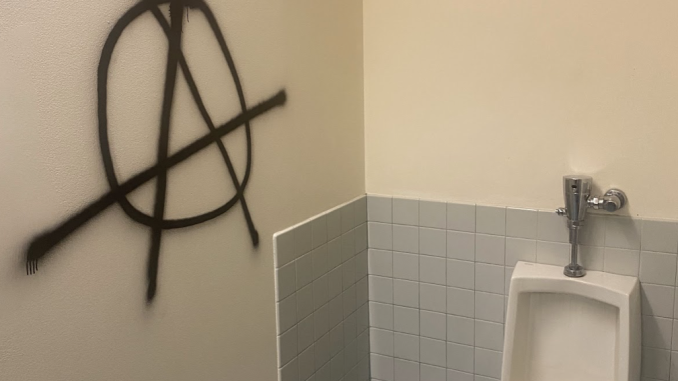
An act of vandalism occurred in the form of a graffitied “anarchy” symbol on the wall
of the first floor men’s bathroom in Olin Hall sometime between Friday, February 24th
and Saturday, February 25th. One student, who chose to remain anonymous to avoid
any connection with the incident, posted a picture of the graffiti on their Snapchat story at around 11 p.m. Friday night. They said, “It certainly gives the school a bad look. Never in my life have I seen someone tag a bathroom like that.”
The graffiti in question, pictured above, was discovered by campus safety on Sunday afternoon. Dan Kelly, Director of Student Conduct at Ursinus, said “Facilities is planning to repaint. They do a temporary measure.” After that temporary cover up, Kelly explained that facilities will fully repaint the wall to ensure the graffiti is no longer visible, which will cost $250.
This incident comes on the heels of multiple incidents of graffiti that occurred during the fall semester, when graffiti appeared on several outdoor sculptures around campus. This raises the question of how the school plans to deal with graffiti vandalism on campus.
Missy Bryant, Dean of Students, said, “When we have been made aware or know who has been responsible for something, we have addressed it and [have] taken it through the conduct process.” But unlike the case of the outdoor sculptures, the nature of the Olin bathroom case makes it difficult for details to emerge. Bryant said, “We rely on students to share what they’ve seen, if anything, because obviously this was in a bathroom. There aren’t any cameras in or near the bathroom, so it would be really hard for us to know who did it, unfortunately.” She added, “That would give us some indication of who it is because if someone just comes in and says, ‘So-and- so did this.’ Unless they saw that, we really wouldn’t be able to move forward in the conduct process.”
That conduct process, which can only be initiated if further evidence comes forth, is
a multi-step process to find out if there has been an official policy violation. Kelly explained, “We review all of the information. . . if we have a student who’s been identified, and the information shows that there was a possible policy violation, we send them what we call a ‘charge letter.’” A charge letter contains a time to meet with the Student Conduct Office and identifies any alleged action that violated the student conduct policy. Kelly explained that the initial meeting between the Office of Student Conduct and the student believed to be responsible for a possible policy violation is called a “process review meeting.” Kelly said, “In that [meeting], we describe to them all of the information they might need to feel prepared to actually meet with an administrator for an administrative hearing.” That administrative hearing, Kelly explained, “is the time when we actually review all of the information. We talk about what the evidence is, we hear from the student, and we make a determination based on the preponderance of evidence on whether they are responsible or not for the policy violation.”
But until any further evidence emerges and that conduct process can begin, Kelly said,
“If anybody has information that they want to share with us, please do. We always talk about bystander intervention, so if anybody is concerned about the behavior that they have witnessed and they have information to share with us because they want us to address it, we need to hear from people.” But until new information emerges, the school cannot be certain if the vandal is even an Ursinus student.
Though if the person is a student, Kelly mentioned other possible outlets for self-expression that are perhaps more productive than graffitiing the walls of bathrooms in academic buildings. He said, “If you want to put out a point of view, you can do that in a manner that doesn’t hurt the college and hurt the community.” Kelly cited the free speech wall, posting flyers, or possibly starting a student organization. He added, “There’s an overwhelming amount of ways that you can do this that is not going to cause any harm.”
The identity of the person behind the Olin Hall graffiti remains a mystery. If, by chance, they read this article with Kelly’s advice, maybe they will transition from academic building art installations to more positive contributions to Ursinus’s campus. After all, Banksy, one of the world’s most famous graffiti artists and political activists, was once heavily criticized for the vandalism that launched him into stardom. Could this just be a misguided college student, or possibly a Banksy-in-the-making? If you have any information on the Olin Hall graffiti, you can always reach out to the Office of Student Affairs, who will keep your identity anonymous.
Chase Portaro chportaro@ursinus.edu
